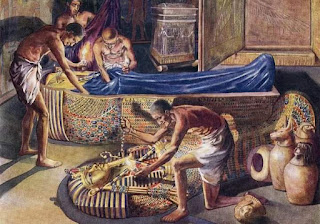CONFESSION OF A TOMB ROBBER:
CONFESSION OF A TOMB ROBBER:
Tomb robbing was rife in ancient times, and it was often quite easy for the robbers to locate a tomb, especially when the tomb of the deceased pharaoh was built to be on display to all who pass by, like a pyramid, for example.
This is why many tombs today are completely devoid of mummies and artefacts. The problem was so serious in ancient Egypt that some pharoahs eventually decided to have their tombs in hidden subterranean rock-cut chambers in the Valley of the Kings (started in c. 1539 BC), which offered better, but not total, protection for their tombs.
But everyone knew that pharoahs and high-ranking people were buried with treasures, and robbers were often provided with inside information. According to Egyptologist David P. Silverman:
"It was no secret that, as the burial process grew more elaborate, so did the value of the grave goods interred with both royal and non-royal mummies. Gilded coffins, amulets of precious stones, exotic imported artifacts all proved too tempting for thieves. When embalmers began to include protective amulets, precious stones, gold, or silver within the mummy wrappings, even the deceased's corpse came under threat. Robbers probably attacked royal tombs soon after the king's funeral, and there is evidence of corruption among the necropolis employees charged with protecting the tombs."¹
The pharoah was viewed by many people as an intermediary between the gods and men. Pharoahs were effectively god-kings (or queens) and many people feared the consequences that awaited them in the afterlife if they were to anger the gods by robbing and desecrating tombs. According to Egyptologist Toby Wilkinson in his book, The Rise and Fall of Ancient Egypt:
"The sanctity of the royal tomb was a fundamental tenet of ancient Egyptian belief, from the very beginning of the pharaonic history. If the prosperity of the land depended upon divine will, and the wellbeing of the gods upon the ministrations of the king, then the eternal survival and benevolence of the monarch was in everyone's interests. The royal tomb was designed, not merely as a final resting place for an Egyptian ruler, but as his passport to the next world and his guarantee of rebirth. As such, it was the single most important structure in the country."
But not all people believed in such superstitions; not all feared what might become of them in the afterlife. Below is the confession of an Egyptian stonemason and convicted tomb robber named Amenpanufer, who lived in the 12th century BC. At his trial he admitted to the authorities that he had robbed the tomb of Egyptian pharaoh, Sobekemsaf II, who had reigned several centuries earlier:
"We went to rob the tombs as is our usual habit and we found the pyramid tomb of King Sobekemsaf, this tomb being unlike the pyramids and tombs of the nobles which we usually rob. We took our copper tools and forced a way into the pyramid of this king through its innermost part. We located the underground chambers and, taking lighted candles in our hands, went down.
We found the god lying at the back of his burial place. And we found the burial place of Queen Nubkhaas, his consort, beside him, it being protected and guarded by plaster and covered with rubble.
We opened their sarcophagi and their coffins, and found the noble mummy of the king equipped with a sword. There were a large number of amulets and jewels of gold on his neck and he wore a headpiece of gold. The noble mummy of the king was completely covered in gold and his coffins were decorated with gold and with silver inside and out and inlaid with precious stones. We collected the gold that we found on the mummy of the god including the amulets and jewels which were on his neck. We set fire to their coffins.
After some days, the district officers of Thebes heard that we had been robbing in the west and they arrested me and imprisoned me in the office of the mayor of Thebes. I took the twenty deben of gold that represented my share and I gave them to Khaemope, the district scribe of the landing quay of Thebes. He released me and I rejoined my colleagues and they compensated me with a share again. And so I got into the habit of robbing the tombs."²
Amenpanufer's fate is not known, but he was likely executed (possibly impaled) along with his accomplices.
. . .
Artist: unknown, sorry.
Notes and further information:
1&2. Both of the quoted texts from World History Encyclopedia article. Link in comment section.











Comments
Post a Comment